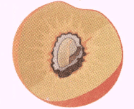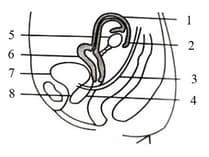Sexual Reproduction
Sexual Reproduction: Overview
This topic covers concepts, such as, Sexual Reproduction, Germ Cells, Cervix & Seed Germination etc.
Important Questions on Sexual Reproduction
Rewrite the terms in the correct order so as to be in a logical sequence.
Implantation, ovulation, child birth, gestation, fertilisation
Generally, pollen grains have a tough protective coat which prevents them from drying up. Insects visit flowers and carry away pollen on their bodies. The transfer of pollen from the anther to the 'X' of a flower is called pollination. Name the structure 'X'.
What is the name of the duct formed by the union of the vas deferens with the duct of the seminal vesicle?
The ejaculatory duct in a human male transports sperm from the rete testes to the vas deferens.
The anther is a part of the carpel that receives pollen grains.
_____ is a part of the stamen that produces pollen grains.
Which of the following is the function of anther?
Explain double fertilisation with a labelled diagram.
The following diagram represents the vertical sectional view of the human female reproductive system.
Mention the name of the part labelled 5.
Which organ enables the developing foetus to obtain nourishment from the mother’s blood?
The layer of the cell that forms the outer layer of the blastocyst is called _____.
_____ is a vestigial organ that acts as the site for the formation of blood cells in the developing embryo.
The uterus is also known as _____.
Write two merits of cross pollination.
The top part of pistil is:
Look at the given diagram and answer the following question.
Which part of the flower develops and become a food after fertilization?

When the egg cell gets fertilised by a sperm, then an event C occurs in the life of mature human female which lasts for the time period Y leading to the birth of a baby. If, however, the egg cell released by the ova does not get a sperm to fuse with, then the thick and soft inner lining of the uterus breaks down and comes out of the female's body in an event called D. The occurrence of event D is controlled by chemical substances E.
Name the chemical substances E.
X and Y are two human beings. The organ A in the reproductive system of X releases a mature gamete B once a month which goes into a tube-like structure C through a funnel-like opening. The organ D in the reproductive system of Y makes and releases gametes E which pass through a duct F and are introduced by an organ of Y, into the body of X.
Out of X and Y, which one is male?
A disc-like special tissue T develops between the uterus wall and embryo through which all the requirements of the developing embryo (and foetus) are met from the mother's body. The embryo is connected to the tissue T through a string like structure S.
What is the name of tissue T?
X and Y are two human beings. The organ A in the reproductive system of X releases a mature gamete B once a month which goes into a tube-like structure C through a funnel-like opening. The organ D in the reproductive system of Y makes and releases gametes E which pass through a duct F and are introduced by an organ of Y, into the body of X.
Name the organ D.

